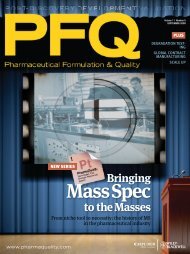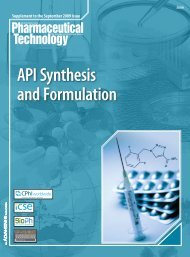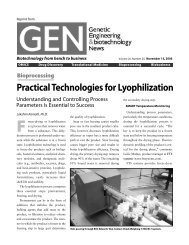High-Temperature Stability | Do the Math for Shelf Life - Sterile ...
High-Temperature Stability | Do the Math for Shelf Life - Sterile ...
High-Temperature Stability | Do the Math for Shelf Life - Sterile ...
- No tags were found...
You also want an ePaper? Increase the reach of your titles
YUMPU automatically turns print PDFs into web optimized ePapers that Google loves.
QUALITY CONTROLCAPSULESwedish scientist Svante Arrhenius provided <strong>the</strong> first kinetic model to interpret <strong>the</strong> effect of temperature on reaction rate. Since <strong>the</strong>n, pharmaceuticalscientists have often attempted to predict long-term chemical stability with insufficient understanding about <strong>the</strong> kinetic model, applying<strong>the</strong> practice in inappropriate situations. Understanding critical temperature relationships is <strong>the</strong> key to more accurately predicting long-term levels<strong>for</strong> a specific product.HIGH-TEMPERATURE STABILITY<strong>Do</strong> <strong>the</strong> <strong>Math</strong><strong>for</strong> <strong>Shelf</strong> <strong>Life</strong>Predict stability usingdata collected at highertemperatures> By Michelle Duncan, PhD,and Irene Zaretsky, MSPharmaceutical scientists routinelypredict long-term chemicalstability at a lowertemperature using data generatedat a higher temperature over a shortertime period. The use of 40 degrees C chemicaldata (e.g., assay and related substances)to predict levels over long-term 25degrees C storage has become such commonpractice that <strong>the</strong> underlying <strong>the</strong>ory isoverlooked or was never learned.There is disagreement about whe<strong>the</strong>rthree months at 40 degrees C indicates expected25 degrees C levels <strong>for</strong> 12 monthsor <strong>for</strong> 24 months because of insufficientunderstanding or in<strong>for</strong>mation about <strong>the</strong>kinetic model. More importantly, withoutsome <strong>the</strong>oretical understanding, <strong>the</strong>practice is inappropriately applied to situationsthat do not fit <strong>the</strong> kinetic modelupon which it is based, resulting in erroneouspredictions.In addition to providing <strong>the</strong> backgroundof how <strong>the</strong>se kinetic predictionswork, this paper will provide <strong>the</strong> key tounderstanding <strong>the</strong> temperature relationshipsand <strong>the</strong> ability to more accuratelypredict <strong>the</strong> expected long-term levels <strong>for</strong> aspecific product.Arrhenius Kinetics: WhereThis All BeganSwedish scientist Svante Arrhenius provided<strong>the</strong> first kinetic model to interpret <strong>the</strong>effect of temperature on reaction rate givenby Equation 1 (see info box). 1-3 The Arrheniusequation can be applied regardlessof <strong>the</strong> order (zero-order, first-order, etc.) of<strong>the</strong> reaction kinetics. 4 Equation 2 presents<strong>the</strong> linear <strong>for</strong>m of <strong>the</strong> Arrhenius equation<strong>for</strong> graphical presentation (y = mx + b).For many reactions, a linear relationshipcan be obtained between <strong>the</strong> inverse oftemperature (in degrees Kelvin) and <strong>the</strong>natural log (Ln) of <strong>the</strong> measured rate constant(k), as shown in Figure 1.Figure 1.THE ARRHENIUS EQUATIONK = A exp (-Ea/RT) (Equation 1)k = reaction rate constantA = Arrhenius factor (y-intercept constant)Ea = <strong>the</strong> energy of activation <strong>for</strong> <strong>the</strong> reaction, cal/mole(1000 cal = 1 kcal)R = <strong>the</strong> ideal gas constant, 1.987 calories/deg moleT = <strong>the</strong> absolute temperature (degrees Kelvin), <strong>for</strong> 25° CT= 298° K and <strong>for</strong> 40°C T= 313° K)THIS EQUATION CAN BE WRITTEN IN SEVERALEQUIVALENT FORMS AS FOLLOWS:Ln k = -Ea/RT + Ln A (Equation 2, y = mx + b)Ln k2/k1 = -Ea/R*(1/T2-1/T1) (Equation 3)k2 = k1 * exp[-Ea/R*(1/T2-1/T1)] (Equation 4)The constants k1 and k2 are <strong>the</strong> rate constants at temperatureT1 and T2 (<strong>for</strong> example 25 degrees C and 40degrees C), respectively.Equation 3 presents a simplified <strong>for</strong>m<strong>for</strong> use with two temperatures. Equation 4expresses <strong>the</strong> relationship between <strong>the</strong>reaction rates and <strong>the</strong> corresponding temperatureswhen <strong>the</strong> activation energy (Ea)of <strong>the</strong> reaction is known. Equation 4 allows<strong>for</strong> <strong>the</strong> calculation of a reaction rate constantat a lower temperature when <strong>the</strong> activationenergy and <strong>the</strong> reaction rate at <strong>the</strong>higher temperature are known.As shown by Figure 1, <strong>the</strong> Arrheniusmodel provides <strong>the</strong> ability to determine <strong>the</strong>reaction rate and, hence, predict stabilityat any temperature with knowledge of <strong>the</strong>activation energy (Ea) and <strong>the</strong> reaction rateat ano<strong>the</strong>r temperature.Limitations to Arrhenius’ ModelThe first requirement is a reaction (ongoing)where <strong>the</strong> reaction rate constant atArrhenius plot of Ln K against1/T. Slope = - Ea/R k = reactionrate constant, T = temperaturein degrees Kelvin Ea = activationenergy, R = ideal gas constant.© DREAMSTIME.COMPharmaceutical Formulation & Quality > April/May 2011






